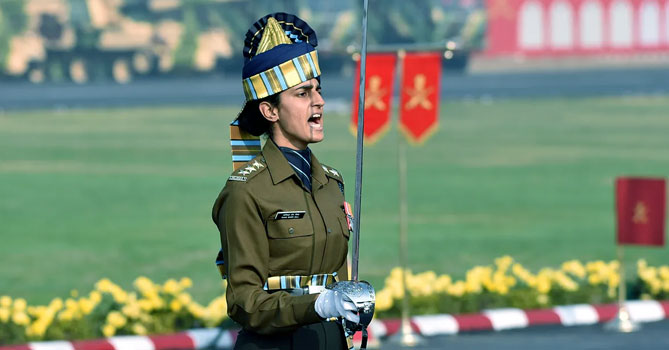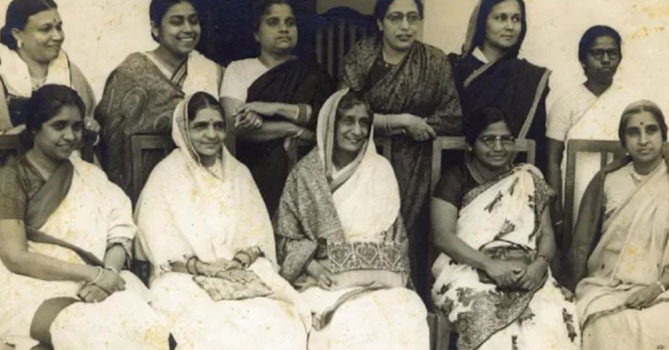
This year’s Republic Day Parade will remain special for Captain Tania Shergill and India as a nation, as she became the first Indian Army female officer to take charge as the Adjutant of the Republic Day parade.
The day, 26 January 2020, saw her lead the men’s contingent as well. As a parade adjutant, she was responsible for the Republic Day parade, a prized appointment that remains an envy of every serving Indian Army officer.
Who is Captain Tania Shergill?
Who is Captain Tania Shergill and why is she an inspiration to other Indian girls aspiring for a career in the Indian Army?
Capt. Shergill is no ordinary person. She comes from a family of rich military history and tradition. Her grandfather served in the Armoured Corps – the 14th Armoured Regiment, also known as Scinde Horse.
Her father served the Regiment of Artillery – 101 Medium, and following their illustrious footsteps, Tania Shergill decided to join the Signals Corps of the Indian Army, after completing her B.Tech in Electronics and Communications. All eyes will be on Capt. Tania Shergill as she leads the all-men contingent on 26 January.
Why should young women consider a career with the Indian Army?
In the latest update, the Supreme Court has cleared lifted a 14-year ban on permanent commissions and has cleared command roles for women.
Joining the Indian Army is an opportunity to serve the nation selflessly and live a life with honour and dignity. Wearing the uniform earns more respect than any other profession, and as a female officer, respect is even more.
Contrary to common perception, the Indian Army life is balanced and offers a fair opportunity to all to pursued diverse activities based on interest, aptitude, and ability. Presently, women are commissioned into the Indian Army as Short Service officers and in non-combat roles only. The officers can serve for periods varying from 5 to 14 years.
But there is great news!
The follow-up to the Prime Minister’s announcement on 15 August 2018, the Ministry of Defence in a press release dated 5 March 2019, announced the Defence forces would begin offering a permanent commission to women. It will be applicable from April 2020.
The eligibility and service branches vary between the three services. The ten branches of the Army thrown open to female officers are:
1. Judge Advocate General (JAG)
2. Army Education Corps
3. Signals Corps
4. Corps of Engineers
5. Army Aviation
6. Army Air Defence
7. Corps of Electronics and Mechanical Engineers (EME)
8. Army Service Corps
9. Army Ordnance Corps
10. Corps of Intelligence
Benefits of serving the Indian Army
- Best training based on the area of interest, qualification, and capability.
- FREE access to the best medical facilities for self and the family, including parents, while in service. Post-retirement, the free facilities extend to the self and spouse. It alone is a great perk and phenomenal savings when one compares with the cost of private medical treatment.
- Children get access to a high standard of education across India through the Army Public Schools and Sainik Schools network.
Here are the other perks:
All serving officers are entitled to free rations. It is a significant saving, given the rising cost of food and groceries. With the forces paid good salaries in addition to free housing, free medical treatment, free rations, and subsidized children’s education, the lifetime savings make joining the defence forces very attractive.
Get to see and know India through different postings across the country, and the opportunity to visit diverse places and meet different communities.
The Army has great holiday homes in premium spots in almost all popular tourist destinations and serving, and retired officers get access for life to these subsidized facilities. The standard of accommodation, food, service, and other facilities beats the best of civilian hospitality.
For lovers of adventure sports and activities, there is no better place than the Army. There is parachuting, parasailing, white water river rafting, camping, trekking, skiing, horse riding, polo, shooting, and all other sports activities. For those with talent, the Army is ready to support your Olympic ambitions too.
For those interested in further academic study, the government allows paid leave to pursue diverse programs.
Finally, there is the Pension. An officer is entitled to a pension for life having served the forces for a minimum number of years. The spouse is entitled to the Pension after the death of the serving or retired officer.
With One Rank One Pension implemented, retired officers earn excellent salaries and maintain a high standard of living, besides continuing to avail superior Officer’s Clubs and Mess facilities, wherever available.
The Army is now recruiting female soldiers below officer rank
Thus far, women were commissioned as officers only. The first batch of 100 female soldiers are currently under training in the Corps of Military Police and will join the service as Personnel Below Officer Rank (PBOR). The Military Police branch of the Army plans to recruit 100 women every year for 17 years, to reach a force level of 1700 women personnel.
How can young Indian women join the Indian Army?
The Indian Army recruits unmarried graduate women into the officer cadre.
There are two ways women can join the Indian Army as an officer.
Through UPSC (Non-Technical)
Female candidates aged between 18-25 years are eligible to sit for the Combined Defence Services Exam (CDS) conducted by UPSC and held twice a year, in July and November. Successful candidates are invited for the Services Selection Board (SSB) interview. Selected candidates then proceed to the Officers Training Academy (OTA) in Chennai to undergo a 49 weeks training starting in April and October.
Non-UPSC (Non-Technical)
Female candidates have the option of joining through:
Judge Advocate General
Graduate Law students between ages 21-27 years can apply directly to the Directorate of Recruitment. Shortlisted candidates are invited to the SSB interview. Selected candidates then proceed to the OTA for training. Batches commence in April and October.
NCC
Female NCC Cadets holding “C’ Certificate with minimum ‘B’ Grade and between ages 19-25 years are eligible to apply directly to SSB. Shortlisted candidates are invited for the interview held twice a year in June-July and December-January. Selected candidates proceed to the OTA for training in April and October.
Technical
Female engineering graduates between ages 20-27 years can apply to the SSB. Short-listed candidates appear for the interview held twice a year, as mentioned above. Selected candidates proceed to OTA for training held in April and October.
The Indian Army is a great career option for aspiring young women. Take the step.




